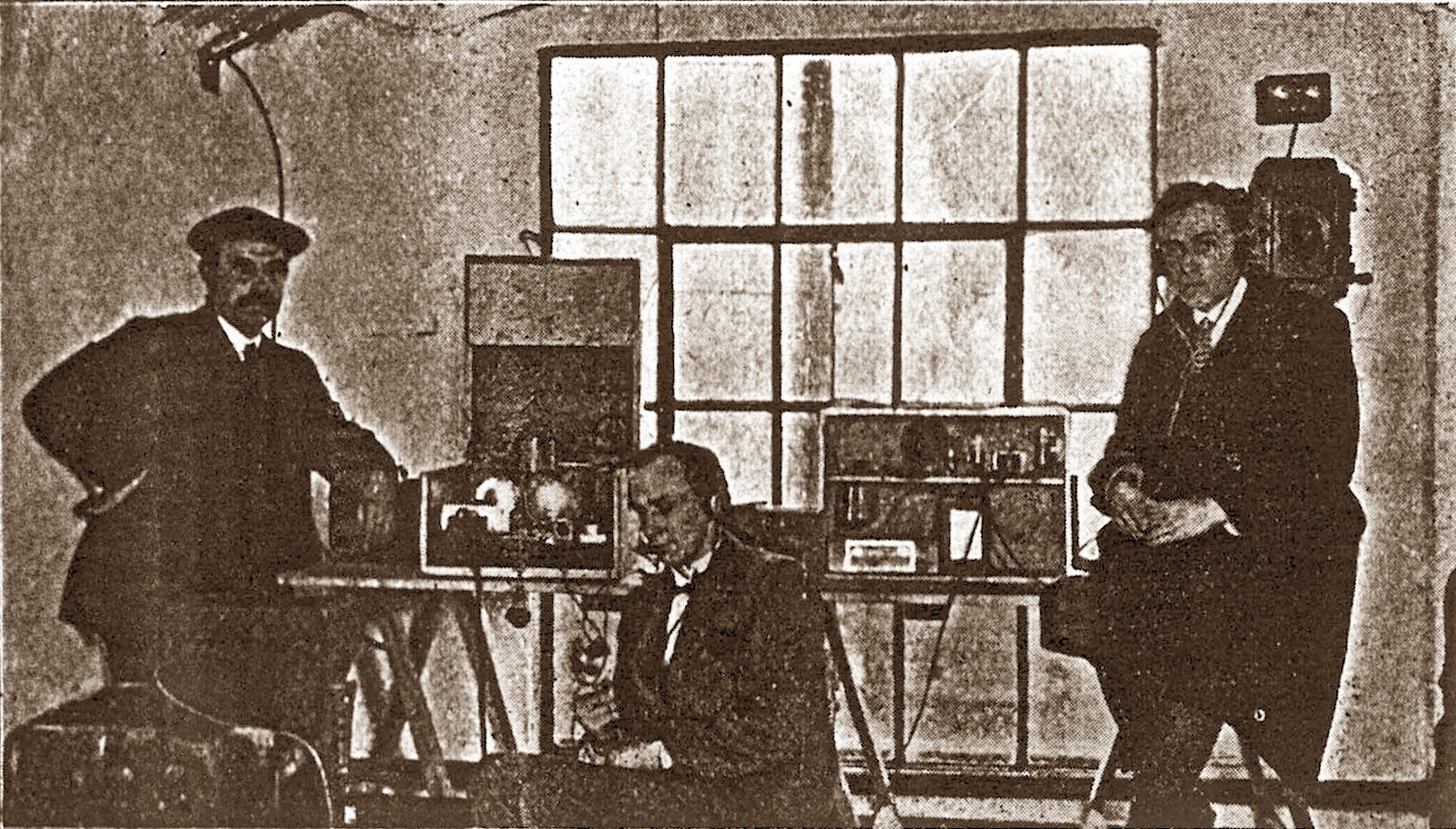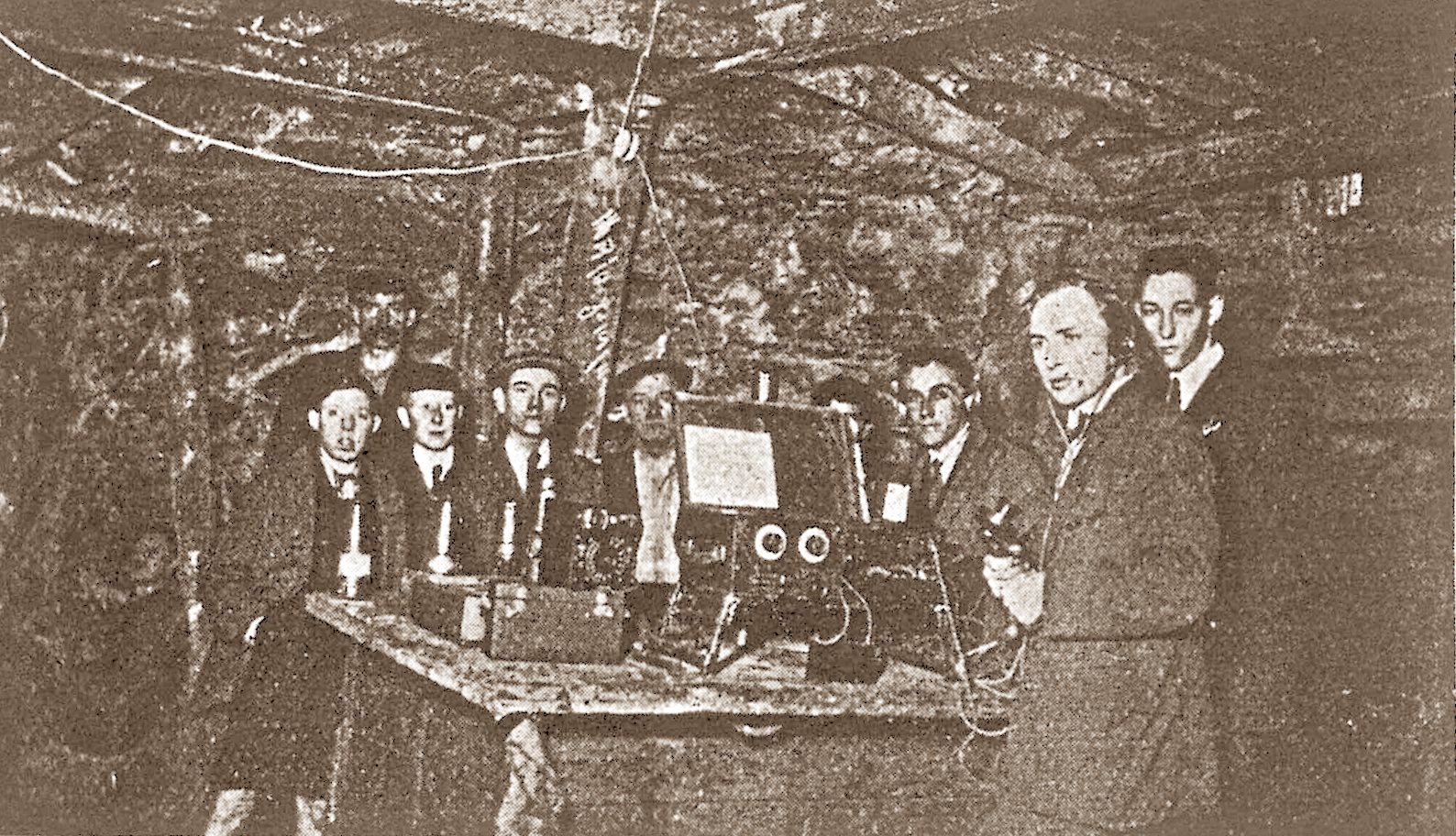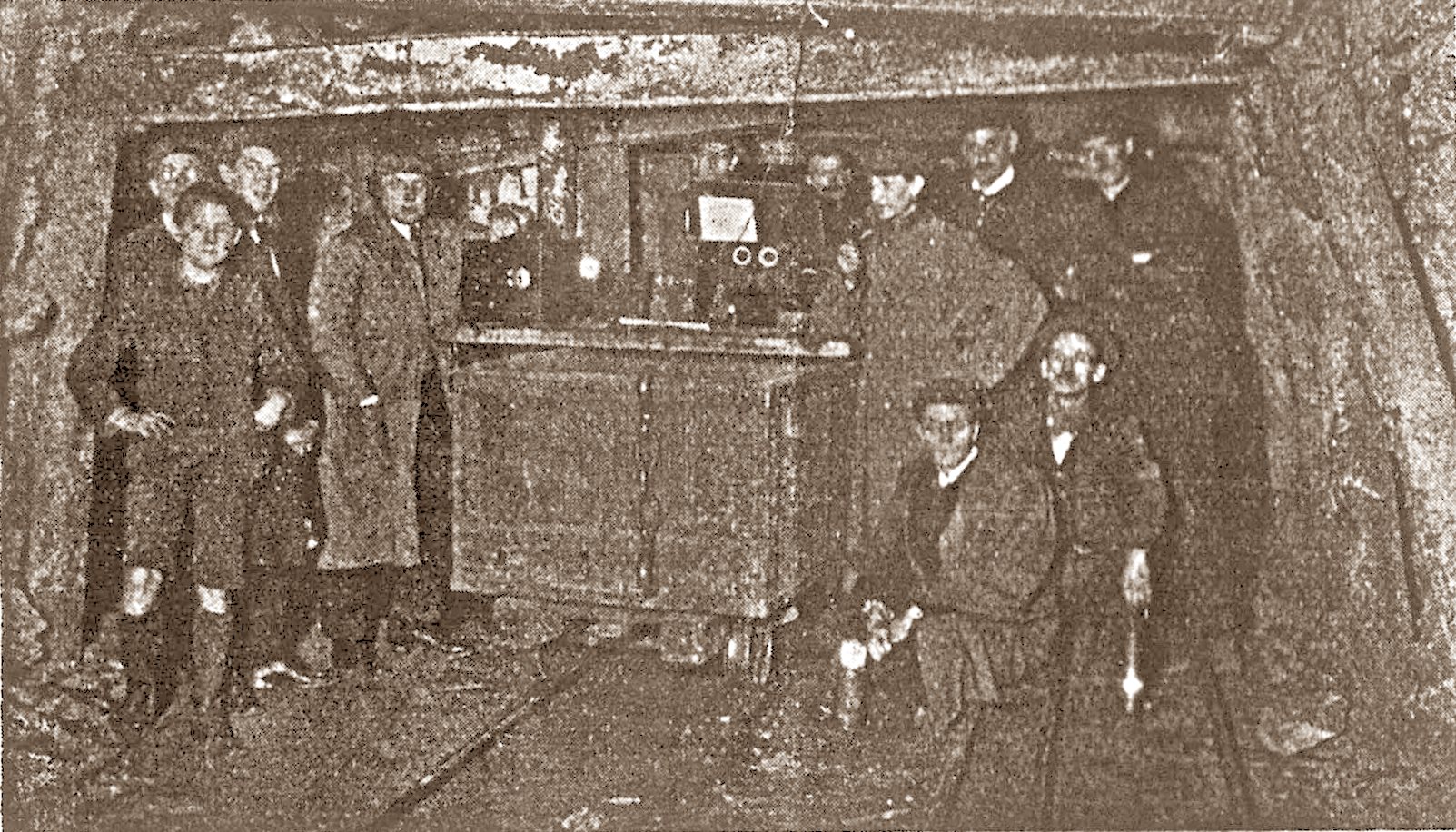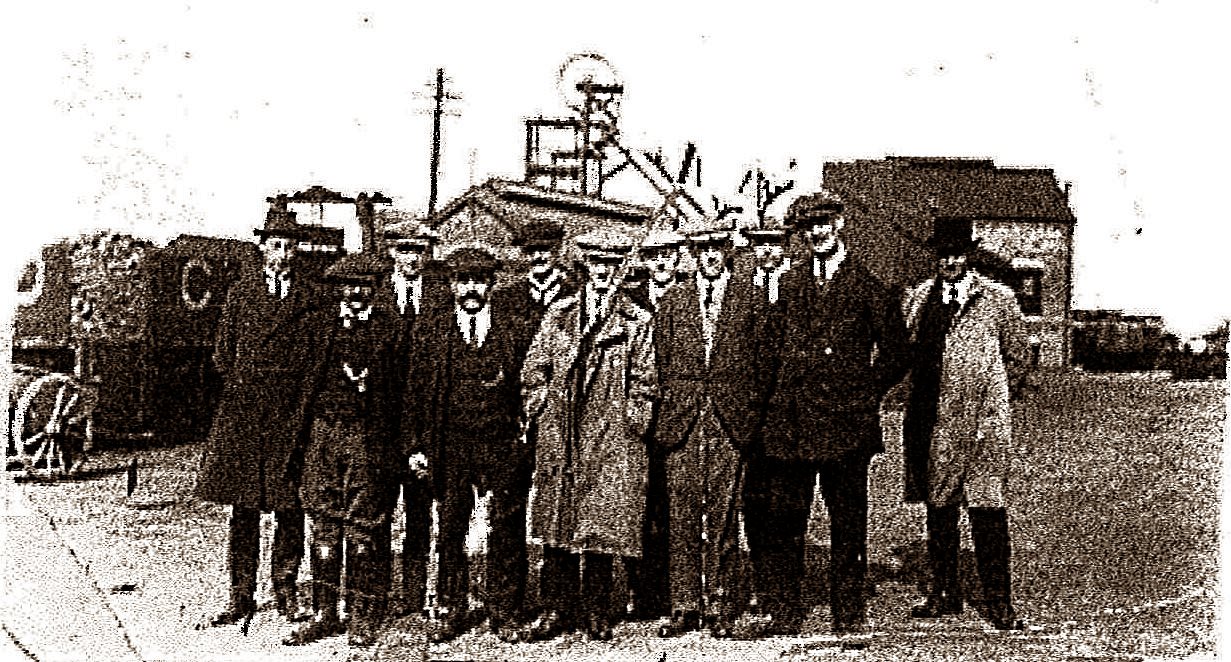-----
By E. E. BRAMALL.
-----
About the middle of the year 1923, in conversation with a few wireless friends, it was suggested that the investigation of the transmission and reception of wireless messages in coal-mines would be both interesting and useful, for if a means of communication could be worked out whereby, in case of a mine disaster where a number of men were imprisoned in the workings through falls of roof or other causes, the imprisoned men could be enabled to communicate with the rescue-party, much valuable time, which in these cases very often means life, would be saved.
A few of the members of the Leicestershire Wireless Society took the matter up, formed a small committee of six, working independently of the Leicestershire Wireless Society, and arranged for a series of experiments to find out what results could be obtained under mining conditions. The committee consisted of Messrs. E. E. Bramall A. I. Scholfield L.D.S (Edin.), Dr F. S. Poole, B.A., M.R.C.S., L.R.C.P., Cyril T. Atkinson, A.I.R.E., H. E. Dyson, and J. W. Pallett, who undertook to act as Secretary to the committee. The mine where the tests were to be made was the Desford Colliery, near Leicester.
A committee meeting was held, and it was decided to go on with the tests; and as both Mr. Atkinson and Mr. Pallett were expert operators, a start was made, using the Morse code, with an ex-Government 2-valve C.W. set very kindly lent by Dr. Poole. The want, however, was felt of a portable receiver for use in the mine, so I undertook to build one of three valves, made up of a H.F., a D., and a L.F. In the meantime the licenses for transmission were to be obtained, and this Mr. Pallett carried out very efficiently, obtaining two licenses, 2 JR and 2 JS, for the Leicestershire Mines Radio Investigation Committee, with a limit of 10 watts on 440 metres.
This committee met four or five times in September and October, 1923, and on November 3rd Tested out the 2-valve C.W. transmitter lent by Dr. Poole, using a TVT unit working from a 6-volt battery and the new portable receiver, built in a suit-case and containing all its own batteries, so as to be quite self-contained for carrying about in the mine. The valves used were the 0.06 Marconi D.E. 3. As the two sets worked quite satisfactorily, it was decided to visit the Desford Colliery.
The committee visited the colliery on Sunday, November 18th 1923. On arrival at the colliery the C.W. transmitter was taken into the store-room, where a space had been cleared, and an aerial erected 35 feet high by about 50 feet long. The transmitter was set up and gave 0.165 ampere in the aerial on a wavelength of 565 metres, which could not be reduced with this set even with the short aerial. Part of the committee then took the receiver underground, leaving two members on the surface to transmit. A test was made at the pump-lodge, 100 yards from the surface. An aerial of indiarubber-covered flex 36 feet long was suspended about midway between the roof and the floor.
Signals in Morse were received O.K, the strength being about R.3, and was considered to be quite satisfactory. However, the H.F. transformer was changed, and then the signals improved to strength R.6, and also during oscillation. The party then went down the pit into the Lower Main Seam, the depth being 238 yardss, and the receiver was set up in the cabin 68 yards south of the pit bottom. The aerial was again set up in the middle of the roadway, but this time consisted of 100 feet of rubber-covered flex hung from the roof by string, and kept central at three other points along the length by pieces of string fastened to the roof-bars, whilst the earth lead was attached to the rails. Signals were received much better at this depth, about R.7 strength.
As by this time it was getting near to broadcasting hours, 2 JR had to stop transmitting, but a little later still 2 JS received in the cabin in the Lower Main Seam the 5 IT concert, which came through at a strength of R.3-R.4. Ship signals were also received on a wavelength of 600 metres.
Our next visit took place on December 2nd, 1903. The 2 JS receiver was taken 1,200 yards due west, whilst the 2 TR transmitter remained as in the first series of tests. No signal could be obtained at this point, due to want of power, as only ordinary R receiving valves were in use for the transmission. The aeria was therefore brought 440 yards from the shaft. The 100-foot aerial running west to east was again used, the tub-rails being used as an earth. Faint signals were heard without using reaction to oscillation point. In test 3 the aerial was reversed and ran from east to west. This improved matters a little, and better signals were obtained.
The two telephony transmitting sets shown in the photographs (Figs. 1 to 3) were finished early in the year 1924, and on March 16th, 1924, the portable 2 JS set was taken to Dr. Poole's house at Wigston and used with a receiving set made by Dr. Poole, whilst the 2 JR set was used at Leicester with the suit-case receiver, the distance being about 3 1/2 miles. 2 JR at first on 440 metres was received at a strength of about R.8.
Fairly good results in modulation and speech quality were obtained.
Twin aerial was used, average height 27 feet, badly screened. Transmission was on a wavelength of from 425 to 440 metres.
In the second test, with an aerial comprising 50 feet of rubber-covered cable, at an average height of 10 feet and a maximum wavelegth of 365 metres, fairly good results were obtained.
On June 22nd, 1924, the transmitting apparatus was again tested. The 2 JR set, choke control series feed, was at Leicester, and the modulation was very good on a wavelength of 440 metres. The 2 JS set, choke control parallel feed, was again at Wigston, and a set series of tests with various aerials were carried out on a wavelength of 370 metres. The reception of theese tests by 2 JR was good under conditions similar to those met with underground.
A third visit was paid to the colliery on July 6th 1924, this being the first time two complete stations for transmission and reception were used. At both stations a portable hand-generator giving 600 volts and xx milliamps. 2 T 15 Marconi valves, and a 6-volt accumulator, were used. Dr. Poole and Mr. Schofield also brought portable sets in addition to the one in a suit-case.
The 2 JR set was erected at the surface in the store-room and a 100-foot single aerial, free end pointing nearly south, and 35 feet high, whilst the 2 JS set was placed in the cabin in the Lower Main Seam 68 yards from the pit-bottom. Good two-way working was established. A second receiving station 1/4 mile in-bye due west of the pit bottom also received very strong signals from 2 JS, but the signals from 2 JR came through only faintly. A buried aerial of 100 feet was tried on the surface, but gave no result.
A fourth visit was paid to the colliery on July 27th, when a 4-wire flat aerial about 40 feet high was tried on the surface, but this was found to increase the wavelength to 530; it was accordingly deduced to a twin wire.
Underground 1/4 mile west of the pit-shaft on the pit-level, the 2 JS set was tried with a 100-foot aerial, the free end pointing east towards the pit-shaft. Good two-way working was established. Signals at 2 JS were received at R.6 strenght, and tuning was very critical. At 2 JR the reception was weak, and fading was prominent at both ends.
At a committee meeting on November 28th, Mr. Hughes was elected a member of the committee and Mr. Harold Hackney as an assistant to the underground transmitter operator.
The fifth series of tests took place on November 30th 1924. The aerial was as before, namely, permanent twin, 100 feet long, 40 feet high. The 2 JS set underground was taken up the south heading, a total distance from the pit shaft of 800 yards. Speech was received well from 2 JR at about R.5 strength, and speech from 2 JS was received very loud and clear. A V-shaped 50-foot twin aerial was tried under-ground at this point, but no advantage was gained, except perhaps that it was a little easier to fix, being shorter.
The sixth series of tests were carried out on December 14th, 1924. The 2 JR set was on the surface as before. The 2 JS set was taken into the Lower Main Seam in the South District to a point of 1,300 yards from the pit-bottom, and within 60 yards of the present working-face, estimated at 3/4 mile through the earth between the stations. The aerial, 100 feet of flxed, was fixed as before, the free end pointing north or towards the shaft, and although maximum power was put into the transmitter, for practical purposes no signals were received at either end, although the carrier wave of 2 JR was heard once, and 2 JR caught a faint signal from 2 JS. The position being in the return air, all the apparatus was covered with moisture due to condensation on the ebonite, and this would cause leakage on the ebonite panels of the sets. When the small amount of energy received by the ordinary broadcast set has been illustrated by taking the case of an ordinary house-fly that walks up a window for 1 inch, and in doing so exercises as much energy as the wireless set receives in ten years. The 2 JS set was moved 200 yards nearer the shaft, but failed to establish telephonic communication. C.W. was then tried, and faint signals were received at both ends. If 2 JS could have been kept in place for some hours, it would have reached the same temperature as the surrounding atmosphere, and so moisture would not have condensed to the same extent on the panels, but the atmosphere would still have remianed damp.
2 JS was then removed to the position given in the last series, when two-way communication of good strength was easily established, showing that the apparatus was working satisfactorily. Another factor that may have contributed to this failure is that in this test there were no signal-wires or haulage-ropes in the roadway, although rails were on the floor, and again formed the earth. In all the other cases both ropes and telephone wires ran parallel to the aerial. There is a suspicion that induction between these and the aerial may have helped to carry the signals.
During one of the tests, when speaking on the portable telephone underground while the 2 JS receiver was in operation; faint speech of the speaker on the surface was heard in the radio receiver, and was presumed to be due to induction via the underground aerial which ran parallel to the telephone-wires. It is therefore quite possible that the signal-wires do help to carry waves to buildings and other wires on the surface, and it is intended to carry out further tests to verify this.
The next meeting, the seventh at the Desford Colliery, took place on January 18th 1925. The surface station 2 JR was as before, whilst the underground station 2 JS was taken into the north-west district, the distance from the pit-bottom being 1,300 yards, or about 1 mile between the surface and underground, measuring the distance a person would travel, but only 3/4 mile in a straight line through the earth between the stations. The underground aerial again consisted of 100 feet of rubber flex, slung in the centre of the roadway and pointing due east towards the shaft, and had a clearance of about 3 feet all round. Signals from 2 JS were received by 2 JR but these were faint. Some slight defect developed in the 2 JS transmitter, and C.W. was tried. This was picked up by 2 JR, but was not good, and the cause of the defect could not be found whilst underground. The signals from 2 JR were received by 2 JS at quite good strength, about R.4, and there is no doubt that good two-way communication would have been established if the fault in the 2 JS transmitter had not occurred.
This is as far as the experiments have taken place, but a very wide field still remains to be covered. The limited power of 10 watts is a great handicap, and I am afraid that in many of the tests this output was exceeded; it will also be necessary to try other wavelengths. In view of the distant transmission to New Zealand on 80 metres, it may be found that these short waves have better penetrating power than the longer ones, and they should therefore be tried, as well as the higher wavelengths around 1,000 metres, before it can be decided which is the best band on which to carry out mines transmission.
In nearly all the above tests, signal-wires have been present, and may have had, as stated above, some influence on the results obtained. This remains to be proved.
Another trouble in tests of this character is that the apparatus in use has to be built compactly; and with transmitters this does not help to increase the efficiency, but the sets must be portable.
Some further concession by the P.M.G. should be granted for increased power up to 50 watts, and for the liberty to try other wavelengths, in order to discover the most suitable conditions under which mine radio communications can be carried out.
The thanks of the committee are due to Dr. Poole, who took the photographs, to the Manager, Mr. Homer, the Under-Manager, Mr. Berry, and the other officials of the colliery, who have spared neither time nor trouble in helping the committee to obtain results from these tests. I must also thank Mr. Taylor, the electrician, who had charge of the portable telephone (land line), and was of the greatest assistance in enabling the two stations to communicate when working signals failed to be established by wireless.
------
The PRESIDENT (Mr. T. G. Lees): Wireless communication is only in its infancy as regards mining work, and possibly, therefore, we may no be able to criticize the paper scientifically. Sir Oliver Lodge, in a letter to The Times of the 21st inst., states that the enthusiasmof some amateurs has led them to devote to the study of wireless transmission a great amount of time and skilled attention, whereby results have been attained which could not have been arrived at so quickly in any other way. If the Wireless Bill becomes law, it will confer on department officials practically unrestricted power to make regulations which, after the lapse of certain days, shall have the force of law. There will be difficulties with regard to the drawing-up of regulations without the help of independent experts who are able to judge the various applications for licenses to experiment in wireless research-work. As Sir Oliver remarks: "You cannot lay down prearranged lines in unexplored territory, you must have freedom to go wrong, to make mistakes, to lose yourselves in the bush in the hope that sooner or later you will emerge into the daylight once more, having cleared some sort of track for your successors." It is to be hoped that the Government Bill will give ample opportunitiees to genuine experimenters to continue their good work.
Mr. Bramall mentions in his paper that his license allows him to use only a current of up to 10 watts, and he suggests that the Postmaster General should concede power up to 50 watts and the liberty to try wavelengths other than the present one of 440 metres. It is to be hoped that Mr. Bramall and his colleagues will continue their interesting work and that he will be able, at some future date, to supplement his paper with any further successes that he may achieve in radio communication in mines.
Mr. B. Mclaren (Pye Hill): Reference is made in the paper to the tub-rails being used for earth. Were the rail fishplated, or were there any other means of bridging the spaces between the rails?
Mr E. E. Bramall (Leicester): The rails were fishplated. The telephone wires are what we suspect most, for they are connected right through from the pit to the surface. The haulage arrangements may be partly responsible - through the haulage-ropes, through the drum and then through the armoured cables up to the surface. It is all induction, due to the presence of these wires and cables; there is no direct communication.
Mr. G. J. Binns (Duffield): Mr. Bramall has not told us in his paper anything about his own work. I happen to know - not from himself but from other sources - that his labour has been very great; he has stuck to it day after day. I noticed the other day in newspaper a report issued by the United States Bureau of Mines that they have come to the conclusion that the matter is one of such extreme difficulty that it is not likely to be of any immediate value; yet when we think of the wonderful developments for which science is responsible to-day, we have hope that the difficulties will not prove to be insoluable. Meanwhile we owe our thanks to Mr. Bramall and those associated with him for their efforts to throw light on this difficult subject.
-----










